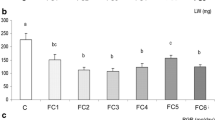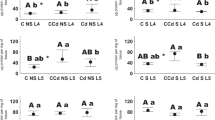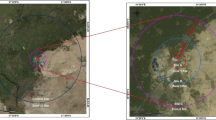Abstract
Cadmium, like many other pollutants, is nondegradable and can be accumulated by Lymantria dispar at a level that affects fitness components, physiology, and development, which could indicate presence of environment pollution by heavy metals. The cadmium effect on fitness-related traits in the third, fourth, fifth, and sixth instar of L. dispar L. was determined. Furthermore, activities of the following antioxidative defense components after the larvae had been fed on the artificial cadmium-supplemented diet (50 μg Cd/g dry food) were assessed: superoxide dismutase (SOD), catalase (CAT), ascorbate peroxidase (APOX), total glutathione amount (GSH), glutathione-S-transferase (GST), glutathione reductase (GR), and the amount of free sulfhydryl (SH) groups. Statistically significant delay of development in the fourth, fifth, and sixth instar and decrease of the larval mass in the third and fourth instar were estimated after the exposure to cadmium through food in comparison to the control. There were no changes in SOD activity of cadmium-treated larvae. Significantly lower CAT, APOX, and GR activities were recorded in the third, fifth, and in the third instar, respectively. At the same time, higher activity was recorded in the sixth instar, while GST activity was higher in the third. GSH content was significantly lower during all instars after treatment but the amount of SH groups was higher in older larvae. The strategy of antioxidative defense and the adjustment or modulation of fitness-related traits in presence of cadmium was dependent on the age of larvae in L. dispar, which might be used in early metal risk assessment in Lepidoptera and other insects.







Similar content being viewed by others
References
Ahmad S (1992) Biochemical defence of pro-oxidant plant allelochemicals by herbivorous insects. Biochem Syst Ecol 20:269–296
Ahmad S (1995) Antioxidant mechanisms of enzymes and proteins. In: Ahmad S (ed) Oxidative stress and antioxidant defenses in biology. Chapman & Hall, New York, pp 238–272
Ahmad S, Pardini RS (1990) Mechanisms for regulating oxygen toxicity in phytophagous insects. Free Radic Biol Med 8:401–413
Badisa VL, Latinwo LM, Odewumi CO (2007) Mechanism of DNA damage by cadmium and interplay of antioxidant enzymes and agents. Environ Toxicol 22(2):144–151
Beutler E (1982) Catalase. In: Beutler E (ed) Red cell metabolism, a manual of biochemical methods. Grune and Stratton, Philadelphia, pp 105–106
Blagojević DP, Grubor-Lajšić G (2000) Multifunctionality of antioxidant system in insects. Arch Biol Sci 52(4):185–194
Bradford M (1976) A rapid and sensitive method for the quantization of microgram quantities of protein utilizing the principle of protein-dye bending. Anal Biochem 72:248–254
Canesi L, Ciacci C, Betti M, Malatesta M, Gazzanelli G, Gallo G (1999) Growth factors stimulate the activity of key glycolytic enzymes in isolated digestive gland cells from mussels (Mytilus galloprovincialis Lam.) through tyrosine kinase-mediated signal transduction. Gen Comp Endocrinol 116:241–248
Cervera A, Maymo AC, Martinez-Pardo R, Garcera MD (2003) Antioxidant enzymes in Oncopeltus fasciatus (Heteroptera: Lygaeidae) exposed to cadmium. Physiol Ecol 32(4):705–710
Cervera A, Mayamo AC, Sendra M, Martinez-Pardo R, Garcera MD (2004) Cadmium effects on development and reproduction of Oncopeltus fasciatus (Heteroptera: Lygaeidae). J Insect Physiol 50:737–749
Chaney RL, Ryan JA, Li Y-M, Brown SL (1999) Soil cadmium as a threat to human health. In: McLaughlin MJ, Singh BR (eds) Cadmium in soils and plants. Kluwer, Dordrecht, pp 219–256
Chinni S, Yallapragda PR (2000) Toxicity of copper, cadmium, zinc and lead to Penaeus indicus postlarvae: effects of individual metals. J Environ Biol 21(3):255–258
Dallinger R, Rainbow PS (1991) Ecotoxicology of metals in invertebrates. SETAC-Europe Conference, Sheffield, England. Lewis, Boca Raton, pp 461
Devkota B, Schmidt GH (2000a) Accumulation of heavy metals in grass and grasshoppers from the Taigetos Mountains, Greece. Agric Ecosyst Environ 78:85–91
Devkota B, Schmidt GH (2000b) Life span and fecundity of Aiolopus thalassinus exposed to dietary heavy metals (Hg, Cd, Pb). Boll Zool Agr Bachic II 32(2):119–134
Ellman CL (1959) Tissue sulfhydril groups. Arch Biochem Biophys 82:70–77
Felton GW, Summers CB (1995) Antioxidant systems in insects. Arch Insect Biochem Physiol 29:187–197
Filipić M, Fatur T, Vudrag M (2006) Molecular mechanisms of cadmium induced mutagenicity. Hum Exp Toxicol 25:67–77
Fornazier RF, Ferreira RR, Pereira GJG, Molina SMG, Smith RJ, Lea PJ, Azavedo RA (2002) Cadmium stress in sugar cane callus cultures: effect on antioxidant enzymes. Plant Cell Tissue Organ Cult 71:125–131
Ginterneiter S, Ortel J, Nopp HJ (1993) Bioaccumulation of cadmium, lead, copper, and zinc in successive developmental stages of Lymantria dispar L. (Lymantriidae, Lepid.)—a life cycle study. Arch Environ Contam Toxicol 25:55–61
Glatzle D, Vuilleumier JP, Weber F, Decker K (1974) Glutathione reductase test with whole blood: a convenient procedure for assessment of the riboflavin status in humans. Exp 30:565–638
Griffith OW (1980) Determination of glutathione and glutathione disulfide using glutathione reductase and 2 vinyl pyridine. Anal Biochem 106:207–212
Habig WH, Pabst MJ, Jakoby WB (1974) Gluthatione-S-transferases. J Biol Chem 249:7130–7139
Halliwell B, Gutteridge JMC (2007) Free radicals in biology and medicine, 4th edn. Oxford University Press, New York
Heliovaara K, Vaisanen R (1990) Heavy-metal contents in pupae of Bupalus piniarius (Lepidoptera: Geometridae) and Panolis flammea (Lepidoptera: Noctuidae) near an industrial source. Environ Entomol 19:481–485
Hossain MA, Nakano Y, Asada K (1984) Monodehydroascorbate reductase in spinach chloroplasts and its participation in regeneration of ascorbate for scavenging hydrogen peroxide. Plant Cell Physiol 25:385–395
Ilijin L, Perić Matruga V, Radojičić R, Lazarević J, Nenadović V, Vlahović M, Mrdaković M (2009) Effects of cadmium on protocerebral neurosecretory neurons and fitness components in Lymantria dispar L. Folia Biol 58(1–2):91–99
Irons RD, Sawahata R (1985) Phenols, catechols, and quinines. In: Anders MW (ed) Bioactivation of foreign compounds. Academic, San Diego, pp 259–279
Ivanović J, Janković-Hladni M (1991) Hormones and metabolism in insect stress. CRC, Boca Raton
Jovanović-Galović A, Blagojević D, Grubor-Lajšić G, Worland R, Spasić MB (2004) Role of antioxidant defense during different stages of preadult life cycle in European corn borer (Ostrinia nubilalis, Hubn.): diapause and metamorphosis. Arch Insect Biochem Physiol 55:79–89
Knežević J (2004) Analysis of pollutant contents in the air and precipitation—EMEP Station Kamenički Vis. In: Kadović R and Knezević M (eds) Forest condition monitoring in the Republic of Serbia, Annual Report ICP Forest 2003, Level I. Minist Sci Environ Prot Serb, FineGRAF.
Korsloot A, Van Gestel CAM, Van Straalen NM (2004) Environmental stress and cellular response in arthropods. CRC, Boca Raton
Lance DR (1983) Host-seeking behavior of the gypsy moth: the influence of polyphagy and highly apparent host plants. In: Ahmad S (ed) Herbivorous insects: host-seeking behavior and mechanisms. Academic, New York, pp 210–224
Lauverjat S, Ballan-Dufrancias C, Wegnez M (1989) Detoxification of cadmium. Ultrastructural study and electron-microprobe analysis of the midgut in a cadmium-resistant strain of Drosophila melanogaster. Biol Met 2:97–107
Li LJ, Liu XM, Duan YH, Guo YP, Cheng B, Guo J, Xi YY, Ma EB (2006) Accumulation of cadmium and copper by female Oxya chinensis (Orthopteta: Acridoidae) in soil–plant–insect system. J Environ Sci 18(2):341–346
Maryanski M, Kramartz P, Lakowski R, Niklinska M (2002) Decreased energetic reserves, morphological changes and accumulation of metals in carabid bettles (Poecilus cupreus L.) exposed to zinc- or cadmium-contaminated food. Ecotoxicol 11:127–139
Mathews MC, Summers CB, Felton GW (1997) Ascorbate peroxidase: a novel antioxidant enzyme in insects. Arch Insect Biochem Pharm 34:57–68
McChaton CP, Pascoe D (1991) Brief exposure of first and fourth instar Chironomus riparius larvae to equivalent assumed doses of cadmium: effects on adult emergence. Water Air Soil Poll 60:395–403
Migula P, Laszczyca P, Augustyniak M, Wilczek G, Rozpedek K, Kafel A, Woloszyn M (2004) Antioxidative defence enzymes in beetles from a metal pollution gradient. Biol Bratisl 59(5):645–654
Mirčić D, Janković-Tomanić MZ, Nenadović VA, Franeta F, Lazarević JM (2010) The effects of cadmium on the life history traits of Lymantria dispar L. Arch Biol Sci 62(4):1013–1020
Mistra HP, Fridovich I (1972) The role of superoxide anion in the antioxidation of epinephrine and a simple assay for superoxide dismutase. J Biol Chem 247:3170–3175
Mouneyrac C, Leving PTY, Leung MY (2011) Cost of tolerance. In: Triquet CA, Rainbow PS, Romeo M (eds) Tolerance to environmental contaminants. CRC, Taylor & Francis Group, Boca Raton
Niu C-Y, Jiang Y, Lei C-L, Hu C (2002) Effects of cadmium on housefly: influence on growth and development and metabolism during metamorphosis of housefly. Entomol Sin 9(1):27–33
Nursita AI, Singh B, Less E (2005) The effects of cadmium, copper, lead, and zinc on the growth and reproduction of Proisotoma minuta Tullberg (Collembola). Ecotoxicol Environ Saf 60:306–314
Odell TM, Bell RA, Mastro VC, Tanner JA, Kennedy JF (1984) Production of the gypsy moth Lymantria dispar for research and biological control. In: King EG, Leppla NC (eds) Advances and challenges in insect rearing. USDA-ARS, New Orleans, pp 156–166
Ortel J (1995) Changes in protein content and free amino acid composition in metalo-contaminated gypsy moth larvae (Lymantria dispar L., Lymantriidae, Lepidoptera). Comp Biochem Physiol C 112:291–298
Pedersen SA, Kristiansen E, Andersen RA, Zachariassen KE (2008) Cadmium is deposited in the gut content of larvae of the beetle Tenebrio molitor and involves a Cd-binding protein of the low cysteine type. Comp Biochem Physiol C 148:217–222
Perić Mataruga V, Janković-Hladni M, Ivanović J (1988) The effect of different feeding substrates on the development of Lymantria dispar L. Plant Protect 39:39–45
Perić-Mataruga V, Blagojević D, Spasić MB, Ivanović J, Janković-Hladni M (1997) Effect of the host plant on the antioxidative defence in the midgut of Lymantria dispar L. caterpillars of different population origins. J Insect Physiol 43(1):101–106
Pickett CB, Lu AYH (1989) Glutathione-S-transferases: gene structure, regulation and biological function. Annu Rev Biochem 58:743–764
Rayms-Keller A, Olson KE, McGaw M, Oray C, Carlson JO, Beaty BJ (1998) Effect of heavy metals on Aedes aegypti (Diptera: Culicidae) larvae. Ecotoxicol Environ Saf 39:41–47
Rayms-Keller A, McGaw M, Oray C, Carlson JO, Beaty BJ (2000) Molecular cloning and characterization of a metal responsive Aedes aegypti intestinal mucin Cdna. Insect Mol Biol 9:419–426
Saint-Denis M, Narbonne JF, Arnaud C, Ribera D (2001) Biochemical responses of the earthworm Eisenia fetida andrei exposed to contaminated artificial soil: effects of lead acetate. Soil Biol Biochem 33:395–404
Schmidt GH, Ibrahim NMM, Abdallah MD (1991) Toxological studies on the long- term effects of heavy metals (Hg, Cd, Pb) in soil on the development stages of Aiolopus thalassinus (Saltatoria: Acrididae). Arch Environ 107:109–134
Shacter E (2000) Quantification and significance of protein oxidation in biological samples. Drug Met Rev 32:302–326
Smith J, Shrift A (1979) Phylogenetic distribution of gluthatione peroxidase. Comp Biochem Physiol 63B:39–44
Sohal RS, Allen RG, Orr WC (1990) Effect of age on superoxide dismutase, catalase, glutathione reductase, inorganic peroxides, TBA-reactive material, GSH/GSSG, NADPH/NADP+, and NADH/NAD+ in Drosophila melanogaster. Mech Ageing Dev 56:223–235
Sokal RS, Rohlf FJ (1981) Biometry. Freeman, San Francisco
The SAS Institute (2003) SAS 9.1.3. Service Pack 4, Cary, NC, USA
US Environmental Protection Agency (1991) Water quality criteria summary list. USEPA, Washington
Vlahogianni T, Dassenakis M, Scoullos MJ, Valavanidis A (2007) Integrated use of biomarkers (superoxide dismutase, catalase and lipid peroxidation) in mussels Mytilus galloprovincialis for assessing heavy metals pollution in coastal areas from the Saronikos Gulf of Greece. Mar Pollut Bull 54:1361–1371
Vlahović M, Ilijin L, Lazarević J (2001) Acute effect of cadmium on larval growth of Lymantria dispar L. Ekol 36:131–137
Vlahović M, Lazarević J, Perić-Mataruga V, Ilijin L, Mrdaković M (2008) Plastic responses of larval mass and alkaline phosphatase to cadmium in the gypsy moth larvae. Ecotoxicol Environ Saf 72:1148–1155
Vlahović M, Perić-Mataruga V, Ilijin L, Mrdaković M, Mirčić D, Todorović D, Lazarević J (2012) Changes in activity of non-specific esterases in cadmium treated Lymantria dispar larvae. Ecotoxicol 21:370–378
Wang Y, Fang J, Leonard SS, Rao KM (2004) Cadmium inhibits the electron transfer chain and induces reactive oxygen species. Free Radic Biol Med 36:1434–1443
Wilczek G, Babczynska A, Augustyniak M, Migula P (2004) Relations between metals (Zn, Pb, Cd, and Cu) and glutathione- dependent detoxifying enzymes in spiders from a heavy metal pollution gradient. Environ Pollut 132:453–461
Wu GX, Ye GY, Hu C, Cheng JA (2006) Accumulation of cadmium and its effects on growth, development and hemolymph biochemical compositions in Boettcherisca peregrina larvae (Diptera: Sarcophagidae). Insect Sci 13:31–39
Acknowledgments
This study was supported by the Serbian Ministry of Education and Science (grant no.173027).
Author information
Authors and Affiliations
Corresponding author
Additional information
Responsible editor: Markus Hecker
Rights and permissions
About this article
Cite this article
Mirčić, D., Blagojević, D., Perić-Mataruga, V. et al. Cadmium effects on the fitness-related traits and antioxidative defense of Lymantria dispar L. larvae. Environ Sci Pollut Res 20, 209–218 (2013). https://doi.org/10.1007/s11356-012-1057-z
Received:
Accepted:
Published:
Issue Date:
DOI: https://doi.org/10.1007/s11356-012-1057-z




